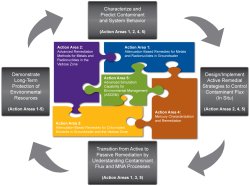Programs Areas
As depicted in the figure on this page, the Office of Groundwater and Soil Remediation Program goals listed below include a number of interrelated action areas with associated objectives (listed further below by action area):
- Characterize and predict contaminant and system behavior (Action Areas 1, 2, 4, 5).
- Design/implement active remedial strategies to control contaminant flux (in situ) (Action Areas 2, 4, 5).
- Transition from active to passive remediation by understanding contaminant flux and monitored natural attenuation processes (Action Areas 1, 3, 5).
- Demonstrate long-term protection of environmental resources (Action Areas 1-5).
Attenuation-Based Remedies for Metals and Radionuclides in Groundwater
Advanced Remediation Methods for Metals and Radionuclides in the Vadose Zone
Attenuation-Based Remedies for Chlorinated Solvents in Groundwater and the Vadose Zone
Mercury Characterization and Remediation
- Remediation and monitoring strategies to control source zone mercury migration
- Innovative technologies for mercury remediation
- Characterization and conceptual modeling of contaminant distribution and transport pathways at Y-12 and ORNL that can be applied at other sites
- Mercury Characterization and Remediation Flier
Advanced Simulation Capability for Environmental Management (ASCEM)

